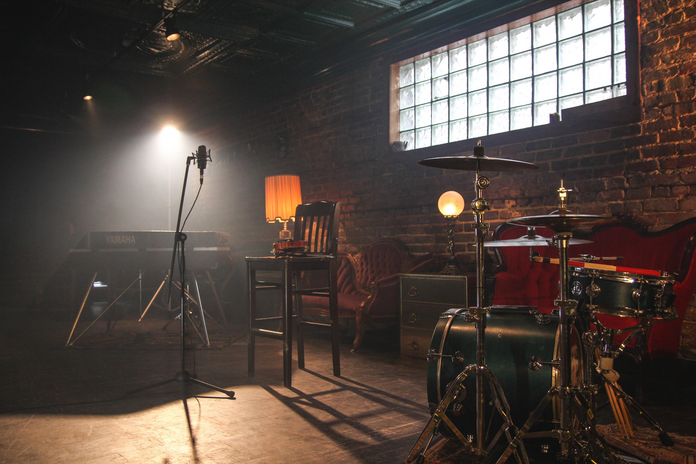Recently, the long-awaited adaptation of Taylor Jenkins Reid’s acclaimed novel Daisy Jones and the Six was released on Amazon Prime, and its release has wrought both the criticism and praise of fans and readers. From comments that actress Camila Morrone has “an Instagram face” and lead Riley Keough has “fake teeth” incongruous with 1970s dentistry to praise regarding the show’s music and costume design, the show is undoubtedly polarizing and galvanizes a broader discussion regarding the creative liberties allowed in book-to-big-screen adaptation.
WARNING: SPOILERS AHEAD.
As someone who has read the book and enjoys the show, I find the inclusion of new subplots and the removal of others included in the books to be more refreshing than blasphemous. For example, the show opts not to kill the band’s original bassist in the Vietnam War, instead sending him to dentistry school and clearing the way for the ever-ambitious Eddie Roundtree (known as Eddie Loving in the book) to play a more pivotal role in the band’s success. Furthermore, the subplot wherein Camila has a one-off rendezvous with Eddie in response to Billy’s emotional affair with Daisy is cathartic and provides relief and satisfaction for two characters who consistently seemed to get the short end of the stick in the book. I also appreciate how the show leaves no stone unturned and attempts to give every character an arc worth following. Simone Jackson, a disco star and Daisy’s encouraging best friend, is given a love interest and an identity in the show that was absent in the book; as a result, viewers are more likely to regard her as the unique, remarkable character she is rather than a supporting character whose sole purpose is to bolster Daisy’s success. I would be remiss if I neglected to mention the storyline between Karen and Graham; while I’m slightly disappointed that the show did not directly adapt the book’s infamous elevator scene, I am nonetheless satisfied with the direction of Karen and Graham’s storyline and convinced by the chemistry between actors Suki Waterhouse and Will Harrison.
Though Pitchfork regarded the show’s original album as more of a “Broadway tribute” to Fleetwood Mac than a realistic representation of mid-1970s rock music, the album’s songwriting and sound is authentic to the blueprint Reid lays out in the book. Many of the songs pertain to the cat-and-mouse, erotically-charged quasi-romance between Billy and Daisy, and while the show chooses to alter certain lyrics, the songs’ core messages remain the same. The show effectively demonstrates how Billy and Daisy use their songs both as routes of communication and as weapons, particularly in episode six with the songs “More Fun to Miss” and “Regret Me.” Though I must admit that the songwriting often veers into cliche, trite territory, Aurora does what it needs to do both as a narrative device and a piece of music worth listening to.
However, my opinions are only some in a sea of broadly-varying reactions to the show’s use of creative liberty, casting decisions, and music. This brings about an interesting discussion regarding the dilemma of adapting literature into film or TV. It seems that, in most cases, adaptation is a losing battle. Following what I dub the “golden age of YA adaptation” beginning with the Twilight saga and decisively ending with The Hunger Games films, quality, universally-lauded book-to-film/tv adaptations are increasingly rare. A recent hit was Hulu’s adaptation of Sally Rooney’s Normal People, a show that was praised for its excellent casting choices, performances, and adherence to its source material. Other adaptations such as Hulu’s Conversations with Friends (also based on a Sally Rooney novel) and Netflix’s lampooned Persuasion adaptation were not so warmly received by the public. This begs a greater question regarding just what makes a quality adaptation, particularly in the age of social media and increasing media criticism.
It appears that in any case, accurate casting is one of the foremost markers of a good adaptation, and DJATS has satisfied this requirement. Not only do the actors fit the physical bill of their respective characters, but they are all able to encapsulate their characters’ defining traits with their performances. From Sebastian Chacon’s goofy and often absentminded Warren to Riley Keough’s fiercely independent Daisy and Sam Claflin’s grave, conflicted Billy, each actor faithfully translates the book’s characters to the silver screen (an impressive feat particularly for up-and-coming actors such as Chacon and Will Harrison, who plays Graham).
Another marker of a proper adaptation is its ability to carefully use creative liberty in producing a body of work that is both independent and true to its origin. To cite the earlier Persuasion example, much criticism of the film arose from the fact that it completely transformed the meek, selfless Anne Elliot into a heavy-drinking, sardonic parody of herself and regularly employed the use of cringeworthy anachronisms to appeal to a modern audience. However, as previously stated, I believe that the DJATS adaptation uses creative liberty as a tool of bolstering understated storylines rather than opting for complete creative override. It’s important to note that this is helped in part by the fact that Taylor Jenkins Reid herself is one of the show’s producers; in any case, though, DJATS appropriately wields creative liberty instead of abusing it.
Unfortunately, DJATS has the unfortunate task of capturing the essence of a bygone era while telling a fictional story in the modern day. The show’s costume design replicates both everyday 1970s fashion and 1970s rock-star fashion relatively well, and the show’s use of actual 1970s music in tandem with the show’s original soundtrack is instrumental in constructing a believable, nostalgia-inducing setting. However, it is difficult to make a twenty-something with access to 21st-century skincare and cosmetic procedures look exactly like a twenty-something in the 1970s. Additionally, because most of us have only ever seen 1970s stars in grainy film, seeing a woman styled in 1970s hair, makeup, and clothing in high quality footage seems a tad uncanny, even when said woman closely resembles stars such as Cher, Ali MacGraw, and Joan Baez. The inability of the modern to perfectly replicate the past appears to be this show’s central weakness with no clear solution in sight. In the end, then, the viewer must decide on their own whether this is an insurmountable barrier to enjoying the show or a good-faith attempt at historical re-creation that can be simply overlooked or even appreciated.
Overall, DJATS possesses most of the hallmarks necessary in creating a faithful adaptation, but its criticism is proof that adaptation is rarely a winning game and is thus a risky but sometimes rewarding creative endeavor.


